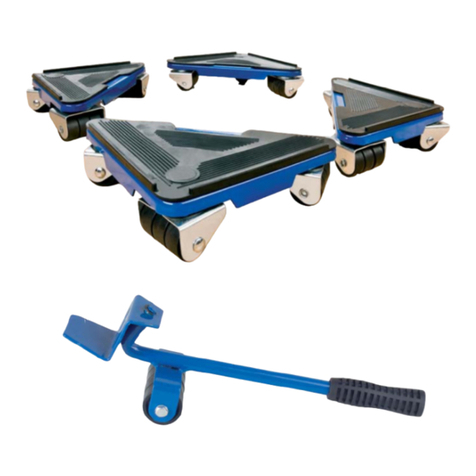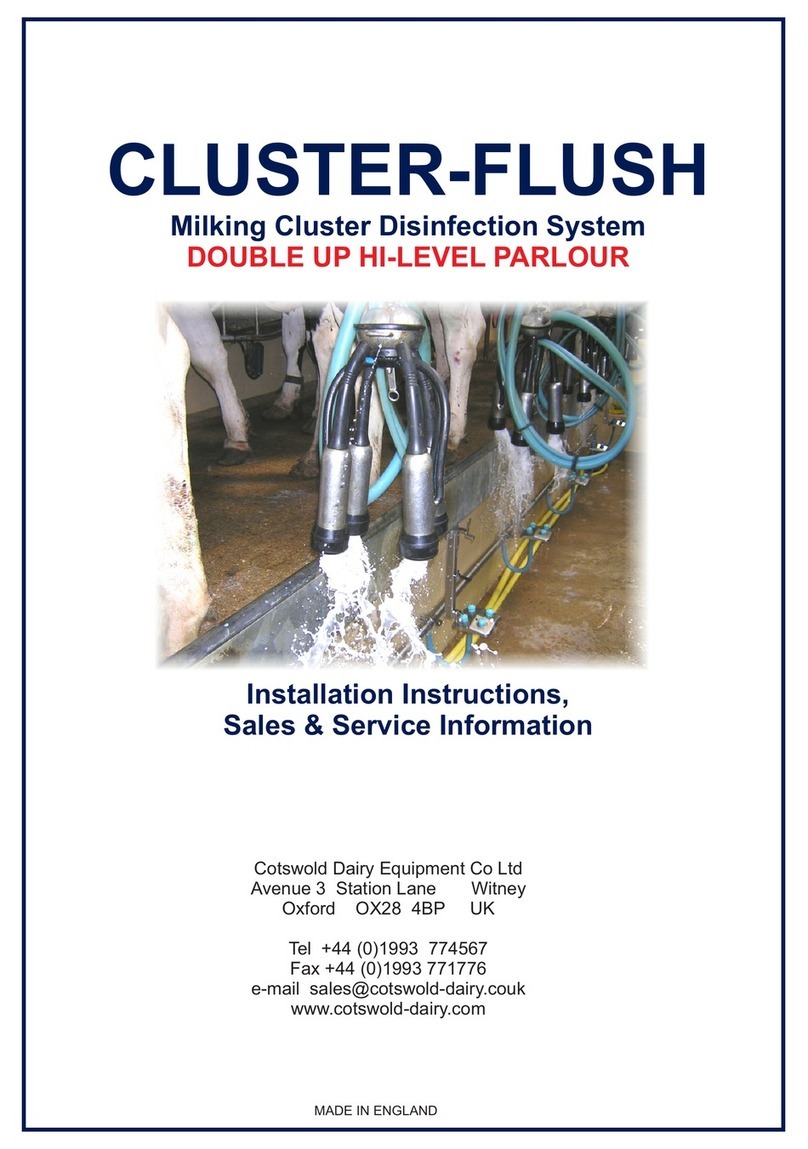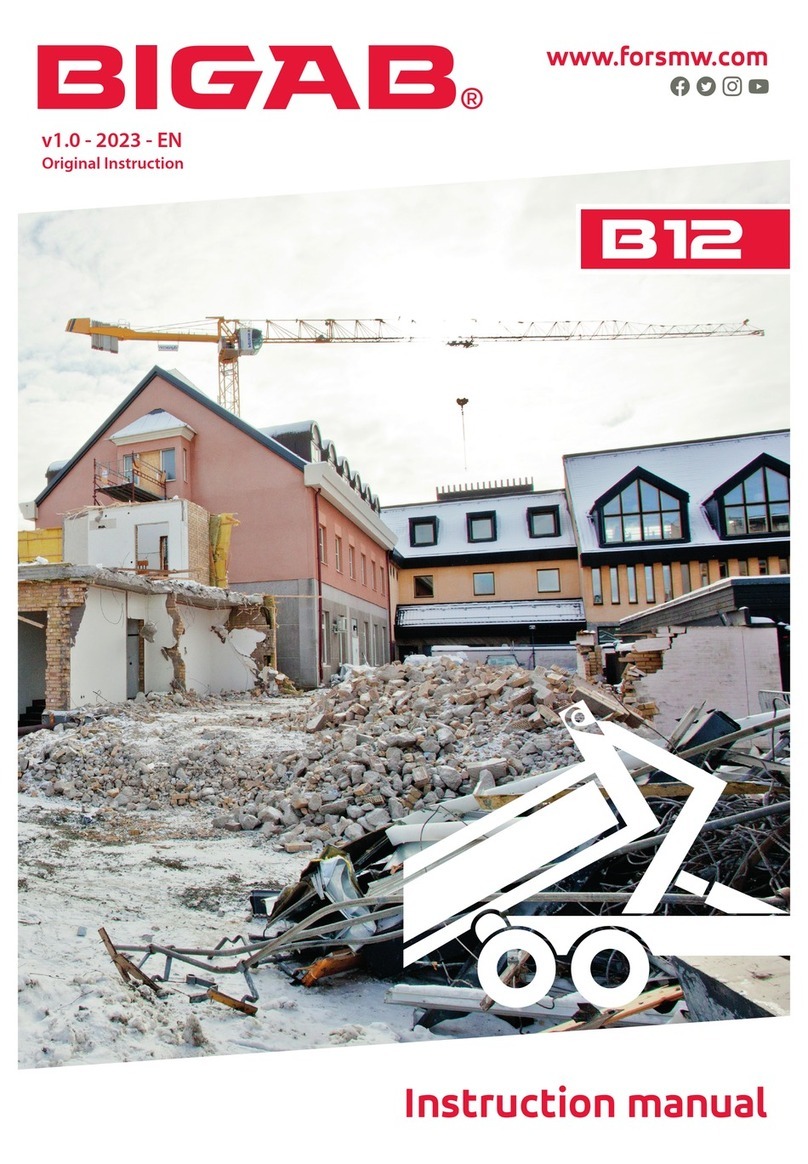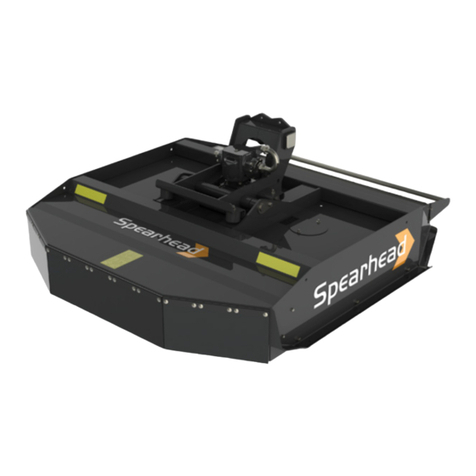Sly France BOSS Series User manual

BOSS DRILL
Internet : www.slyfrance.com
Tel: +33 (0)5 53 40 32 95
Fax: +33 (0)5 53 40 61 36
SLY France SAS
La Madeleine 47210 BOURNEL
OPERATING INSTRUCTIONS

2
Table of contents
1Introduction................................................................... 4
1.1 Foreword ............................................................ 4
1.2 Service ................................................................ 4
1.3 Damage .............................................................. 4
2Safety and responsibility............................................ 4
2.1 Intended use...................................................... 4
2.2 Spare parts ........................................................ 5
2.3 Operating Instructions..................................... 5
2.4 Qualification of personnel............................... 5
2.5 Groups of operators ......................................... 5
2.6 Children in danger............................................ 5
2.7 Personal protective outfit ............................... 6
2.8 Safety in traffic.................................................. 6
2.9 Safety in operation........................................... 6
2.9.1 Commissioning............................................. 6
2.9.2 Damage to the machine ............................. 6
2.9.3 Hitching and unhitching ............................. 7
2.9.4 Hydraulics...................................................... 7
2.9.5 Pressure accumulator................................. 7
2.9.6 Pneumatics ................................................... 7
2.9.7 Brake system................................................ 8
2.9.8 Overhead lines.............................................. 8
2.9.9 What to do in case of voltage flashover.. 8
2.9.10 Technical limiting values............................ 8
2.9.11 Use in the field............................................. 8
2.9.12 Changing wear items .................................. 9
2.9.13 Transport....................................................... 9
2.10 Fertiliser and dressed seed ............................ 9
2.11 Environmental protection................................ 9
2.12 Retrofits.............................................................. 9
2.13 Care and maintenance .................................. 10
2.14 Delivery............................................................. 10
2.15 Loading and unloading.................................. 10
2.16 Safety stickers................................................. 11
2.16.1 Meaning of the stickers:........................... 11
2.16.2 Position of safety stickers:....................... 12
3Technical Specifications........................................... 13
3.1 Technical data................................................. 13
3.2 Type plate ........................................................ 13
3.3 Dimensions...................................................... 14
3.4 Calculating the ballasting ............................. 16
4Operation..................................................................... 17
4.1 Connecting....................................................... 17
4.2 Hydraulic connection..................................... 17
4.3 Electrical connection ..................................... 17
5Getting Started........................................................... 18
5.1 Unfolding.......................................................... 18
........................................................................................... 18
5.2 Hoppers............................................................ 18
5.2.1 Access to hoppers ..................................... 18
........................................................................................... 18
5.2.2 Filling............................................................ 18
5.2.3 Draining the hopper .................................. 18
5.3 Small seed hopper.......................................... 19
5.4 Seed transportation ....................................... 19
5.5 Calibration of the metering unit................... 19
5.6 Disassembling the rotor................................ 20
5.7 Roller change................................................... 20
5.8 Folding.............................................................. 20
6Settings........................................................................ 20
6.1 Setting the sowing depth and the angle of the
pressing wheel ............................................................... 20
6.1.1 Quick adjustment system......................... 20
6.1.2 Quick adjustment system of the side
wheel (option) ............................................................ 21
6.2 Adjusting the hydraulic pressure................. 21
6.3 Adjusting the turbine ..................................... 22
6.4 Setting the row cleaners (option)................ 22
6.5 Setting the drill shoes.................................... 22
6.6 Adjustment of side wheels ........................... 22
6.7 Metal strapping of cleaning wheel.............. 23
6.8 Disk cleaning scraper .................................... 23
6.9 Adjustment of markers (option) .................. 24
7Brake system .............................................................. 24
7.1 Hydraulic brake............................................... 24
7.2 Pneumatic brake............................................. 25
7.3 Parking brake .................................................. 26
8Hydraulic...................................................................... 26
8.1 Suspension of the drawbar........................... 26
8.2 Hydraulic system folding / turbine.............. 27

3
8.3 Hydraulic system with CETOP..................... 28
8.4 Hydraulic system drill unit ............................ 29
9Operating instructions of the controller ................ 30
9.1 Operating instructions of RDS ISOCAN
ARTEMIS.......................................................................... 30
9.2 Operating instructions of SOFTIVERT touch
pad. 30
10 Maintenance ........................................................... 30
10.1 Disk and hub assembly ................................. 30
10.1.1 Disk 18’’....................................................... 30
10.2 Security reminder ........................................... 31
10.3 Cleaning............................................................ 31
10.4 Storage ............................................................. 31
10.5 Maintenance.................................................... 31
10.5.1 Daily maintenance..................................... 31
10.5.2 Annual maintenance ................................. 31
10.5.3 Lubrication points...................................... 32
11 Problem and troubleshooting .............................. 32
12 Appendix.................................................................. 34
12.1 Tightening torques ......................................... 34
12.2 Rotor selection table...................................... 35

4
1 Introduction
1.1 Foreword
Before putting the machine into operation, the
instructions in this operating manual must be carefully
read and followed. This prevents hazards, reduces
repair costs and downtime, and increases the reliability
and service life of your machine. Observe the safety
instructions!
SLY FRANCE declines all responsibility for damage and
malfunctions resulting from non-compliance with this
manual.
This manual is intended to make it easier for the user to
get to know his machine and to exploit the possibilities
of use in accordance with the intended use.
This operating manual must be read and applied by all
persons responsible for working on or with the machine,
e. g.:
-Operation (including preparation,
troubleshooting during work, maintenance)
-Maintenance (maintenance, inspection)
-Transport
The warranty period starts from the date of delivery.
Subject to changes in the illustrations and indications
concerning the technical characteristics and weights
indicated in this manual, aimed at improvement.
The illustrations in this user manual show different
versions of the mounted / coupled implement as well as
different equipment.
1.2 Service
SLY FRANCE wants you to be completely satisfied with
your machine and us.
In case of problems, contact the sales manager in your
area.
1.3 Damage
The machine has been carefully manufactured by SLY
FRANCE. Flow anomalies that can lead to a total
shutdown can, however, be caused, even in the event of
correct use, for example by:
-Damage due to external influences
-Wear of wear parts
-Missing or damaged work equipment
-Incorrect speeds of advancement
-Incorrect adjustment of the device (incorrect
assembly / coupling, non-compliance with the
adjustment instructions)
-Failure to follow the user manual
-Maintenance and maintenance not or poorly
executed
You must therefore check, before each use and during
the work of your machine, whether it is working properly
and whether the accuracy of the flow is sufficient.
Any claim for compensation for damages that have not
occurred directly on the machine is excluded. The
responsibility of the company cannot be held liable for
damages due to misbehavior and use.
2 Safety and
responsibility
The following danger and safety instructions apply to all
chapters of this manual.
The machine is built according to the current state of
the art and the recognized technical safety rules. Its use
may, however, present a danger of injury or death to the
user or third parties and / or result in damage to the
machine or other equipment.
Read and follow the safety instructions below
before using the machine!
2.1 Intended use
The machine is intended to be used for sowing and / or
normal cultivation according to the specific rules in the
agricultural field. Any other use or use beyond the
intended scope, such as use as a means of transport,
for example, is considered improper use and may result
in injury, if not death, to persons.
SLY FRANCE declines any responsibility for the damage
that may result. The user assumes full responsibility.
Adhere to the accident prevention regulations of the
Mutual Agricultural Insurance Funds and the other
generally recognized rules on safety, occupational
health and road safety.
Use the machine only in perfect technical condition
according to its destination and in full knowledge of the
risks!

5
Immediately remove any incidents that may affect
safety.
The machine must only be used, maintained and
repaired by persons familiar with it and informed of the
dangers.
2.2 Spare parts
The original SLY FRANCE spare parts and accessories
are specially designed for this machine.
Other spare parts or accessories are neither controlled
nor authorized by SLY FRANCE.
The assembly or use of parts that are not of the SLY
FRANCE brand may lead, in certain cases, to
unfavorable modifications to the characteristics of the
machine and thus to the safety of persons and the
machine.
The responsibility of the company SLY FRANCE cannot
be held liable for damages due to the use of parts and
accessories that are not original.
When safety stickers are affixed to the component to be
replaced, they must also be ordered and affixed to the
replacement component.
2.3 Operating Instructions
Proper use also implies compliance with the
instructions in the operating manual as well as the
manufacturer's instructions for use, care and
maintenance.
The user manual is a constituent part of the machine!
The machine is exclusively intended for use in
accordance with the user manual. Failure to observe the
operating manual may result in serious injury, if not
death, to persons.
Before work, read and observe the corresponding
chapters of the user manual.
Keep the operating manual handy.
Return the user manual to the following users. To put
back in the language of the country in case of resale in
a country where one speaks another language.
2.4 Qualification of personnel
Improper use of the machine can lead to serious injury,
if not death, of people. To avoid accidents, everyone
working on the machine must meet at least the
following general criteria:
She must be physically able to control the machine.
It is able to carry out work on the machine in compliance
with safety in the context of this manual.
She knows how the machine works as part of her job
and is aware of the hazards of the job. It can estimate
and avoid work-related hazards.
She understands the user manual and can apply the
information it contains.
She is familiar with the safe driving of vehicles.
For driving on the road, she is aware of the respective
rules of the highway code and has a driving license in
good standing.
An apprentice must always be supervised when working
with the machine.
The operator must:
-Regulate the scope of responsibilities,
competence and supervision of staff.
-Train and instruct the staff if necessary.
-Give the operator the possibility to have access
to the user manual.
-Make sure that the operator has read and
understood the user manual.
2.5 Groups of operators
People working with the machine must be trained
accordingly to perform the various tasks.
These persons must have been instructed in the tasks
to be performed by the operator or a sufficiently
qualified person. This concerns the following tasks:
-Road transport
-Use and adjustment
-Operation
-Interview
-Troubleshooting
2.6 Children in danger
Children are not able to assess hazards and behave
unpredictably. They are therefore particularly
threatened:
Keep children away.

6
Especially before starting and triggering the movements
of the machine, make sure that no children are in the
danger zone.
Before getting off, stop the tractor.
Children can trigger dangerous movements on
the machine. A machine parked insufficiently
secure and unattended is a danger for children
playing nearby!
2.7 Personal protective outfit
Missing or incomplete protective equipment increases
the risk of damage to health. Personal protective
equipment means, for example:
Well-fitting clothing / protective clothing, if necessary,
a fishnet for the hair
Safety shoes, protective gloves
Protective goggles to protect against dust or splashes
when handling fertilizers and liquid fertilizers (follow
fertilizer manufacturer's instructions)
Respirator mask and protective gloves when handling
disinfectants or disinfectant-treated seed (follow
disinfectant manufacturers' instructions)
Determine the personal protective equipment for the
respective task.
Keep available protective equipment that is effective
and in perfect condition.
Never wear a ring or other jewel.
2.8 Safety in traffic
It is forbidden to take passengers on the
machine!
Observe the permitted widths and heights of transport.
Take into account the transport height especially to
pass under bridges and low power lines.
The axle loads, tire load capacities and total permissible
weights must be adhered to, so that sufficient steering
and braking accuracy is maintained. The front axle must
always have a load of at least 20% of the unladen weight
of the tractor.
For road transport, the machine must be in the transport
position. The machine must be folded and locked.
Before folding, the folding areas must be free of soil.
This is to prevent damage to the mechanical system.
Mount the lights, signaling and protection devices and
check the operation.
Before driving on the road, clear the entire machine of
the soil that has clung to it.
Driving is influenced by mounted / hitched tools.
Particularly when cornering, take into account the large
overhang and the mass of inertia of the mounted /
hitched tool as well as the degree of filling.
Raised machinery (three-point hydraulic system):
Take into account the lack of stability and
manoeuvrability of the tractor.
For transportation on public roads, respect the
maximum speed allowed in the traffic permit!
Always adapt driving to road conditions to prevent
accidents and damage to the chassis and transport
wheels. Consider personal skills, road conditions,
traffic, vision and weather.
2.9 Safety in operation
2.9.1 Commissioning
Without proper commissioning of the machine, its
operational safety is not guaranteed. This can cause
accidents and serious injury, if not death, of people.
Use the machine only after having received the
necessary instructions from the authorized dealer,
factory representatives or employees of SLY FRANCE.
The completed acknowledgment of receipt must be
returned to SLY FRANCE.
The machine should only be used if all safety devices
and devices related to safety, e.g. removable guards
(shims, etc.) are in place and working well.
Regularly check the tightness of the nuts and bolts,
especially those of the wheels and work tools, and
tighten them if necessary.
Regularly check the tire pressure.
2.9.2 Damage to the machine

7
Damage to the machine can adversely affect the
operating safety of the machine and cause accidents.
This can lead to serious injury, if not death, of people.
The following elements of the machine are particularly
important for safety:
-Hydraulic system
-Brakes (if applicable)
-Connecting devices
-Protective devices
-Lighting
If in doubt as to the safe state of the machine, for
example when disposing of consumables, visible
damage or behavior unexpectedly changed: stop the
machine immediately and secure it.
If possible, determine the damage using this instruction
manual and dispose of it.
Eliminate possible causes of damage (e.g. coarse dirt or
loosened screws).
Faire réparer le dommage par un atelier spécialisé
qualifiéquand il peut nuire àla sécuritéet quand vous
ne pouvez pas y remédier vous-même.
2.9.3 Hitching and unhitching
Presence of a single operator, the driver hitch and
detects his own machine. Use the external lift controls.
Make sure that no one can stand between the tractor
and the machine or in an environment close to the
machine when coupling or unhitching.
Before getting off the tractor, to hitch or unhitch, set the
parking brake, stop the engine and remove the ignition
key from the tractor.
Before hitching up your machine, make sure that the
hitch pins, hitching lugs or ball joints do not show signs
of wear, breakage or incompatibility with your tractor.
Depressurize your hydraulic system before connecting
or disconnecting the hydraulic connections.
Connect or disconnect the electrical connections.
Lower the machine completely to the ground before
unhitching. Check that the surface is flat and
sufficiently firm to ensure perfect machine stability
during storage.
When your machine is parked, make sure that it is stable
so that it does not cause bodily injury or property
damage.
2.9.4 Hydraulics
The hydraulic system is under high pressure.
Spray may penetrate under the skin and cause
serious injury. In case of injury, consult a doctor
immediately.
The hydraulic system of the machine has several
functions that can cause personal injury and property
damage if mishandled.
Do not connect the hydraulic hoses to the tractor until
the system is depressurized on the tractor side and the
machine side.
The hydraulic system is under high pressure. Regularly
check for leaks and visible damage from outside on all
lines, hoses and connections!
Use only appropriate means to check for leaks.
Immediately correct the damage! Oil splashes can
cause injuries and fires!
To prevent handling errors, mark the plugs and plugs of
the hydraulic connections.
In case of injury, consult a doctor immediately!
Secure or lock tractor valves when not in use!
Replace the hydraulic hoses at the latest after six years.
2.9.5 Pressure accumulator
In the hydraulic system, there are possibly pressure
accumulators.
Do not open pressure accumulators or work on
them (welding, drilling). Even after emptying,
the tanks are still under gas pressure.
Before carrying out any maintenance work, the
hydraulic system must be depressurized!
2.9.6 Pneumatics
Observe the installation order of the pneumatic
connections.
Before connecting the pneumatic circuit, clean the
tractor and machine connections, and check that there
is zero pressure on the tractor side and the machine
side.
Replace damaged or worn pneumatic hoses and
observe dimensional features.

8
For all interventions on the pneumatic system, place the
machine on the ground, depressurize the pneumatic
circuit.
2.9.7 Brake system
Depending on the equipment, the machines may be
equipped with a pneumatic or hydraulic service brake
system.
The braking system must always be connected and
function properly when driving on the road.
After hitching the machine and before transporting,
always check the condition and function of the braking
system first.
Check the setting on the brake force regulator.
Always first release the parking brake before traveling.
Before unhitching, always stop the machine against
rolling and apply the parking brake.
2.9.8 Overhead lines
When the side sections are unfolded and folded, the
machine can reach the height of overhead lines. The
voltage can then be discharged on the machine and
cause a fatal electric shock or fire.
When the side sections are folded and when unfolding
and folding, be sure to maintain a sufficient distance
from the high voltage power lines.
Never unfold or fold side sections near electrical
pylons and overhead lines.
Never climb on or under the overhead lines to
avoid the risk of electric shock due to voltage
surges.
2.9.9 What to do in case of voltage
flashover
Voltage discharges cause high voltages outside the
machine. Significant voltage differences appear on the
floor around the machine. Taking big strides, lying on
the floor or leaning on them with your hands can lead to
deadly electric currents (step voltage).
Do not leave the cabin.
Do not touch metal objects.
Do not make a conductive connection with the earth.
Notify people: DO NOT approach the machine. Electrical
voltages on the ground can cause strong electric
shocks.
Wait for the help of professional lifeguards. The airline
must be cut.
If people must leave the cabin despite voltage
discharges, for example when there is danger of
immediate death from fire:
-Jump from the machine. Make sure to jump
while maintaining stability. Do not touch the
outside of the machine.
-Move away from the machine.
2.9.10 Technical limiting values
When the machine's technical limit values are not
observed, this may be damaged. This can cause
accidents and serious injury, if not death, of people.
The following technical limit values are particularly
important for safety:
• total weight allowed
• maximum axle loads
• maximum load transfer
• Maximum speed
Also observe the maximum loads of the tractor.
2.9.11 Use in the field
It is forbidden to take passengers on the
machine!
Before start-up and commissioning, make sure that
nobody is near the machine (children). Ensure that
visibility is sufficient.
Ensure sufficient stability of the machine in case of
longitudinal and transverse inclination on uneven
ground. Observe the permissible limit values for the
tractor.
None of the protective devices prescribed and delivered
shall be dismantled.
Make sure that nobody is in the pivot area of
hydraulically operated machine parts.
Do not move the machine in reverse when it is lowered.
The components are dimensioned only for forward
movement in the field and may be damaged in the event
of reverse.

9
2.9.12 Changing wear items
Stall the machine so that it does not move
unexpectedly!
The raised sections of the chassis under which you are
located must be securely locked with suitable supports!
Projecting parts (plowshares, etc.) can
represent a risk of injury!
Never climb rotating parts to mount on the machine.
These could turn and you could be seriously injured by
falling.
2.9.13 Transport
The use of the machines must always be done in
accordance with the directives and rules in force,
concerning accident prevention, road safety and
occupational health.
Before moving, check the tightness of the wheel studs
and tandem mounting bolts (if so equipped). Check the
pressure and condition of the tires.
Do not drive with too low pressures or damaged tires or
rims.
When transporting, use all the lighting and signaling
devices required by the law in force in the country of
use. If necessary, they can be removed during field work
so as not to be damaged.
The user is responsible for compliance with current
regulations and monitoring changes.
Regularly check the condition and fixing of the hitch
pins, do not hesitate to change them in case of wear.
The hitch joints of the tractor may also show signs of
wear, do not hesitate to replace them with new hinges.
Ride at a reasonable speed and comply with the
legislation so as always to keep control of the coupled
assembly.
Pay special attention in rough terrain or hills. Before
approaching a descent, engage a lower gear.
The tractor used to move the machine on the road must
have the same weight and power as that used for field
work.
Never maneuver when a person is near the machine or
tractor.
For machines equipped with a folding for transport,
make sure that no person or obstacle is in the sweeping
area when the elements fold down.
Observe all the rules of caution when driving, especially
when cornering and when the road is narrow.
Take all precautions before leaving the tractor.
Apply the parking brake, stop the engine, remove the
ignition key.
When traveling on the road, do not allow anyone to ride
on the machine or between the machine and the tractor.
2.10 Fertiliser and dressed seed
Improper handling of fertilizers and seeds treated with
disinfectants can lead to poisoning and death.
Follow the indications in the product manufacturer's
safety data sheet. If necessary, request the safety data
sheet from the dealer.
Determine the personal protective equipment according
to the manufacturer's instructions and make them
available.
2.11 Environmental protection
Consumables such as hydraulic oil, lubricants, etc., can
harm the environment and people's health.
Do not allow consumables to pollute the environment.
Absorb spilled consumables with absorbent material or
sand, collect them in a liquid-tight container and mark
and dispose of in accordance with statutory regulations.
2.12 Retrofits
Construction modifications and expansions may affect
the proper operation and operational safety of the
machine. This can lead to serious injury, if not death, of
people.
Do not make any construction modifications or
extensions that are not authorized by SLY FRANCE.
Only have the machine converted or extended by a
specialized workshop or by an operator trained for this
purpose by SLY FRANCE.
Observe national regulations for weights, weight
distribution and dimensions.
or equipment affecting weight or weight distribution, the
requirements for the coupling device, the load report
and the axle load shall be checked and observed.
With machines without brakes, a braking system may
have to be fitted later if the weight limits are exceeded.

10
For all changes to the nameplate data, a new nameplate
with the current data must be installed.
For changes concerning the indications of the
authorization of circulation, this one must be renewed.
2.13 Care and maintenance
Improper maintenance and servicing threaten
the operational safety of the machine. This can
cause accidents and serious injury, if not death, of
people.
Observe the intervals prescribed for periodic
inspections and inspections.
Maintain the machine according to the maintenance
plan, cf. chapter "Care and maintenance".
Only perform the work described in this user manual.
Carry out maintenance and service work after placing
the machine flat on a stable floor and after stalling to
prevent it from moving.
Depressurize the hydraulic system and lower the work
tool or support it with appropriate means.
Before proceeding with work on the electrical
installation, disconnect it from the power supply.
Before performing welding work on the machine,
disconnect the cables from computers and other
electronic components. Mount the grounding terminal
as close as possible to the weld.
Before cleaning the machine with a pressure washer,
cover all openings where it should not enter water,
steam or cleaning agent for safety and functional
reasons. Do not direct the water jet directly at electrical
or electronic components, bearings or blower. For high-
pressure or steam cleaning, always keep 50 cm from the
parts of the machine.
After cleaning, check all hydraulic lines for loose leaks
and connections.
Examine the wear due to friction and deterioration.
Immediately remedy the defects found!
Tighten all loose screw connections during
maintenance and maintenance work.
Do not wash new machines with a steam jet or high-
pressure cleaner. The paint did not harden until after
about 3 months and could be damaged before.
2.14 Delivery
As a general rule, the machine and tools are delivered
fully mounted on a low loader truck. If parts or
subassemblies have been dismantled for transport, they
will be reassembled on site by our dealer or by our
assemblers.
Depending on the model of the low loader used, the
machine can be lowered by pulling it behind a tractor or
must be unloaded with suitable lifting equipment (lift or
crane).
Only use lifting gear and tools with sufficient load
capacity and approval!
2.15 Loading and unloading
Load and unload with a tractor.
Hitch or unhitch the machine to the tractor to load it
onto a truck or to unload it from the truck.
An assistant is needed to guide maneuvers.
Attach or remove the transport locks.

11
2.16 Safety stickers
Be careful not to damage the safety stickers when washing the machine. Make changes to damaged
or missing stickers.
2.16.1 Meaning of the stickers:
Sticker
Description
Sticker
Description
380135
Stay away when folding.
Stay clear of moving parts when
unfolding.
305021
Stop the engine and remove the
key.
Stop the engine and remove the
ignition key before any maintenance
or repair work.
305016
Foot crush zone
Stay well away from moving parts.
355001
Read the user manual.
Read the operating manual and
safety tips before start-up and take
them into account during operation.
355054
Crush risk zone.
Never operate in an area where
there is a risk of crushing as long
as parts can move.
355063
Stay well away from power lines.
Stay well away from high voltage
power lines.
355049
Locking device.
Set up the locking device before
any intervention.
305064
Hydraulic leak.
Follow the instructions in the user
manual for maintenance
operations.
355062
Transport on the machine.
Never carry passengers on the
machine.
355048
Scan area.
Stay away from the sweeping area.
355035
Rotating parts.
Never put your hands in the
rotating area of the moving screw.
380299
Moving parts.
Never ride on rotating parts. Only
use devices intended for mounting.

12
Sticker
Description
002
Clamping the wheels.
Check the tightness of the wheels after 8 hours of use.
2.16.2 Position of safety stickers:
The safety stickers with the "x 2" supplement are located on both sides of the machine.
355048
355016
355049
355062
380299
002
380135
355063
355054
305035
355001
355021
355064
355062
355065
x 2
x 2
x 2
x 2

13
3 Technical Specifications
3.1 Technical data
Working width (m)
3
4
4,5
6
7
Transport width (m)
2,99
Transport height (m)
3,23
3,29
3,97
4,45
Length (m)
7,18 –7,80 (triple hoppers)
Weight (kg)
4 850
5 310
6 240
6 650
7 200
Simple hopper capacity (l)
1200 or 2000
Double hopper capacity (l)
2400 or 4000
Triple hopper capacity (l)
3600 or 6000
Hopper opening dimension (m)
0,77 x 0,91
Hopper filling height (m)
2,63 (hopper 1200L) or 3,12 (hopper 2000L)
Number of sowing coulters
12 - 16 - 18
16 - 20 - 22
- 24
24
24 - 30 - 32
- 36
28
Row spacing (cm)
16,7 - 18,75
- 20 - 25
16,7 - 18,75
- 20 - 25
18,75
16,7 - 18,75
- 20 - 25
25
Tire size
500/60R-22.5
Tire size (option)
710/50R-26.5
Work speed (km/h)
6 - 15
Max speed transport (km/h)
25
NOTE:
Subject to modifications as a result of technical improvements.
The weight of the coupled implement depends on the equipment; indication with minimal equipment.
The heights and widths of transport permitted on public roads may vary from country to country.
Comply with national registration requirements.
3.2 Type plate
The type plate with the CE marking is located on the frame of the machine.

14
3.3 Dimensions
BOSS drill 3m :
BOSS drill 4.5m :

15
BOSS drill 6m :
BOSS drill 7m :

16
3.4 Calculating the ballasting
The mounting or coupling of tools must not lead to exceeding the total permissible laden weight, the axle load
and the characteristics of the tractor tires.
PV Unladen weight of the tractor.
CAV Load on the front axle of the empty tractor.
CAR Load on the rear axle of the empty tractor.
MAV Front weight (if present).
RAR Load report of the coupled machine.
a Distance between the centre of gravity of the front tool and the centre of the front axle.
b Wheelbase of the tractor.
c Distance between the centre of the rear axle and the centre of the coupling point of the rear lower
arms.
All weight data are in (kg). All measurement data are in (m).
Calculation of the minimum ballast at the front:
Calculation of the actual load on the front axle:
Calculation of the total real weight:
Calculation of the actual load on the rear axle:
Calculated values must not exceed the allowable values.
Actual value obtained
by calculation
Authorized value
according to user
manual
Value x 2 of the tire load
Minimum
ballast before
MAV (min)=
Total weight
P(total)=
≥
Front axle load
CAV (total)=
≥
≥
Rear axle load
CAR (total)=
≥
≥
MAV
RAR
CAV
CAR

17
4 Operation
4.1 Connecting
Before hitching up the machine, make sure that the
machine is properly secured.
1. Check the wear and the cleanliness of the couplings
of the machine and the tractor.
2. Approach the tractor to the machine
3. Hitch the machine.
a) Machines with hitch on the lift arms:
➢Hitch the machine
➢Block the catch-up hooks
➢Tighten the stabilizers to avoid lateral
movements
➢Make sure to adjust the lift level so that the
machine frame is in a horizontal position
➢Connect the hydraulic brake plug
b) Machines with coupling ring:
➢Adjust the height of the drawbar so that the
machine can be hitched.
➢Hitch the machine.
➢Insert the bolt and lock it.
➢Connect the hydraulic brake plug
c) Machines with ball hitch:
➢Lower the drawbar or the cap on the ball and
raise the machine slightly.
➢Position the blank holder.
➢Check and adjust the size of the gap between
the blank holder and the cap
4. Fold up the crutches and lock them thanks to the
dowel provided for this purpose.
4.2 Hydraulic connection
The operation of the drill requires:
-1 double acting hydraulic distributor for
unfolding and folding the wings of the machine
-1 double acting hydraulic distributor to raise
and lower the sowing elements in the field
-1 double hydraulic distributor for the use of
tracers (optional)
-1 single effect for feeding the hydraulic turbine
-1 free return (male in ¾) to the hydraulic oil
tank of the tractor for the oil return of the
turbine.
Never operate the valve controlling the turbine
without properly connecting the free return,
otherwise the motor can be damaged.
When using a tractor with variable displacement pump
and integrated regulators (closed circuit), use the
tractor controller to adjust the speed of the turbine
The oil flow required for a rotation speed of the turbine
of about 4500 rpm is 45 l / min.
➢Clean the hydraulic connections before
connecting
➢Connect to a double acting distributor, the
hydraulic hoses feeding the folding.
➢Connect on a double-acting distributor the
hydraulic hoses for the markers.
➢Connect the free return of the turbine (photo)
➢Connect to a single-acting distributor the
power supply of the turbine
4.3 Electrical connection
1. Connect the electrical signaling socket.
2. Connect the power plug of the regulator (photo)
3. Connect the cigarette lighter power plug of the touch
pad.

18
5 Getting Started
5.1 Unfolding
1. Remove the wing locking safety pins
Do not position yourself under the wing of the
drill to remove the axes.
2. Actuate the corresponding hydraulic distributor until
the wings are completely unfolded
Warning before unfolding the wings, check that
the sowing units are in the up position.
5.2 Hoppers
Whether the machine is in single configuration, double
or triple hoppers, these are strictly identical and
designed to receive all types of seed and solid fertilizer.
The choice in the allocation of the hoppers is up to the
user depending on the convenience of use.
5.2.1 Access to hoppers
Before accessing the hoppers make sure that the
seeder is perfectly immobilized and that the wings are
unfolded.
1. Remove the pin and the bearing pin from the left rear
row.
2. To open the hoppers activate the locking levers.
Be careful the hoppers are pressurized, do not
proceed to open the hoppers when the hydraulic
turbine is running.
5.2.2 Filling
Before filling the hoppers, we recommend closing the
hopper bottom hatches.
When closing the hoppers make sure that no grain or
foreign matter remains trapped between the lid gasket
and the hopper
After each opening of the hoppers and after prolonged
shutdowns, check the tightness while the blower is
operating. Start the blower and look for air exhaust from
the lid with your hand or at the ear.
In case of leaks, replace seals or tighten hinges and
closures. Sealing defects with air losses cause dosing
errors.
IMPORTANT SAFETY NOTES
- Take care never to go under a suspended load.
- Ensure that no one passes through the changing area
of the material handling equipment used for loading.
- When the load approaches the hopper, make sure that
no one is standing on the bridge.
- Mount on the bag only when the load is stabilized
above the hopper opening.
- When loading, avoid contact with the treated seed and
wear gloves and a dust mask.
- The intervention on a big bag is done only when the
bag is stabilized.
5.2.3 Draining the hopper
1. Put the seeder in the transport position.
2. Position a big bag or container under the machine.

19
3. Open the drain hatch on the side of the hopper.
4. If necessary, operate the metering device in forced
operation to completely empty the bottom of the hopper.
5.3 Small seed hopper
As an option, it is possible to equip the BOSS single,
double or triple seed drill with an additional 280L hopper
for small seeds.
➢Unlock to open (A) and turn counterclockwise.
➢Turn clockwise to close and lock (A).
5.4 Seed transportation
The metering unit are made of stainless steel and
plastic as well as rotors.
Each metering unit is equipped with a valve allowing the
cut of half-drill (1 row on 2).
To send the contents of the hopper into the seed drill,
the lever must be in the middle position. To choose only
one of the two rows, position the lever on the
corresponding row. Repeat this action on all the
metering unit.
5.5 Calibration of the metering
unit
1. Fit the appropriate dosing device according to the
quantity and type of seed (see table and dosing
instructions).
2. Turn on the seed drill control pad and go to the
calibration setup menu (see using the tablet).
3. Fill the hopper.
4. Open the guillotine hatch to release the seed or
fertilizer.
5. Open the hatch under the dispenser, actuate the
valve to orient the flow of the selected side for
calibration.
6. Insert the receptacle for this purpose (photo).
7. Proceed to the "flow test" phase (see the use of the
tablet).
8. Remember to close the hatch once calibration is
complete.
IMPORTANT:
At each change of product, variety or
metering
unit
roll a new calibration is required. A change of dose
without changing the product does not require a new
calibration.
A

20
5.6 Disassembling the rotor
Regularly check the rotors to avoid any clogging and
dosing errors.
Unscrew both handles on each side of the rotor.
Then remove the rotor from its housing.
5.7 Roller change
Remove the circlip holding the different rotors on the
hexagonal axis using a hammer and a flush pin.
Then place the rotors corresponding to the type of seed
and the chosen dose (see adjustment table).
Each rotor has a specific volume, adapt the choice of
rotors to the desired volume.
From left to right the volumes are: 3 cm3, 67.7 cm3,
203.3 cm3
Be sure to complete with full rotors before replacing the
circlip.
Be sure to replace the metering unit rotation sensor
correctly.
5.8 Folding
IMPORTANT SAFETY NOTES
Make sure no one is on the seed drill or hopper access
ramps.
Move people away from the danger zone.
1. Ensure that the sowing units are in the up position,
fully folded before reloading the machine.
2. Remove the locking pins.
3. Actuate the hydraulic distributor corresponding to the
folding of the drill.
4. Lock the wings with the locking pins.
6 Settings
6.1 Setting the sowing depth
and the angle of the
pressing wheel
Before adjusting the depth, check the horizontal plumb
of the machine. Make sure the elements are in the up
position and do not touch the ground.
6.1.1 Quick adjustment system
6.1.1.1 Depth adjustment
Pull the handle and position it on the desired notch
thanks to the graduated adjustment plate.
This manual suits for next models
5
Table of contents
Popular Farm Equipment manuals by other brands

Euro Systems
Euro Systems P130 Translation of the original
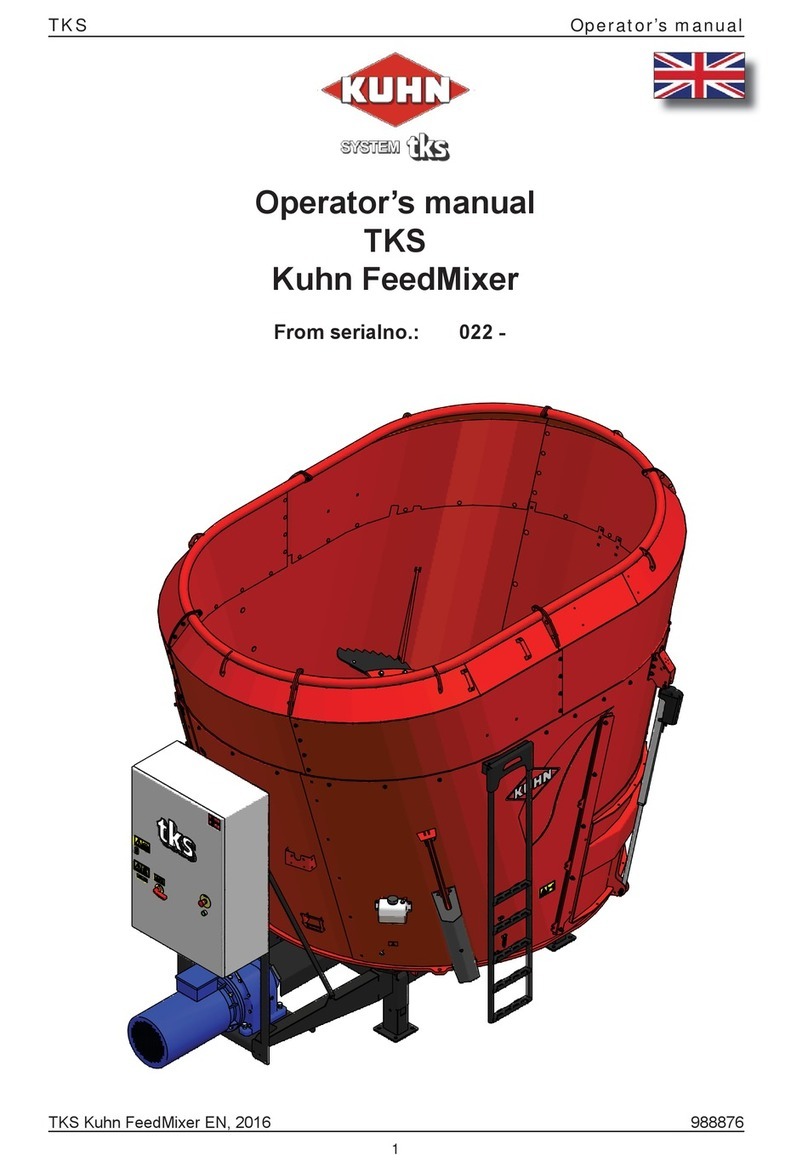
TKS
TKS Kuhn FeedMixer Operator's manual
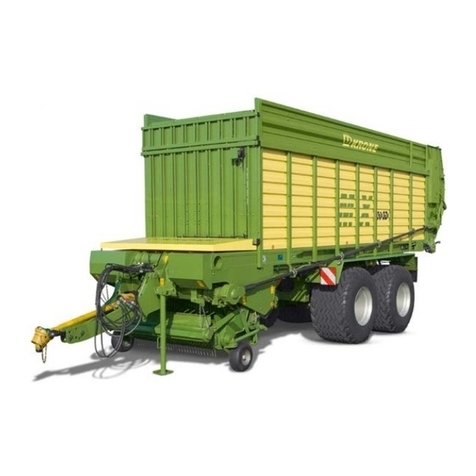
Krone
Krone MX 310 GL Original operating instructions

Kemper
Kemper 300F Operator's manual
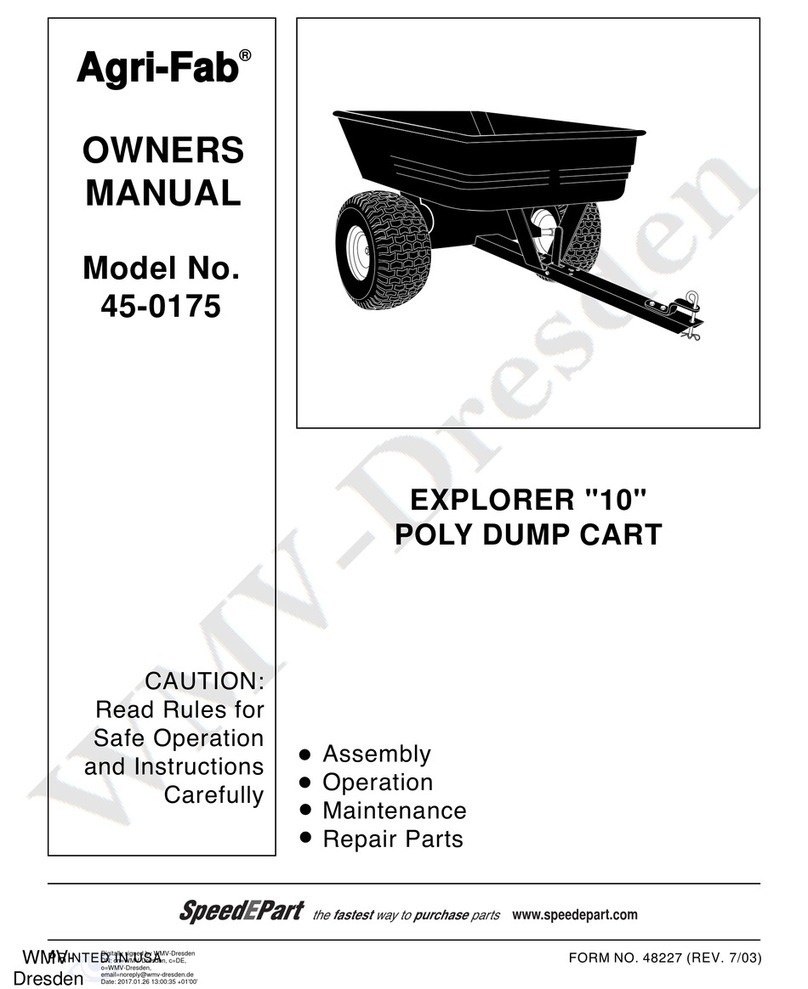
SpeedEPart
SpeedEPart Agri-Fab 45-0175 owner's manual
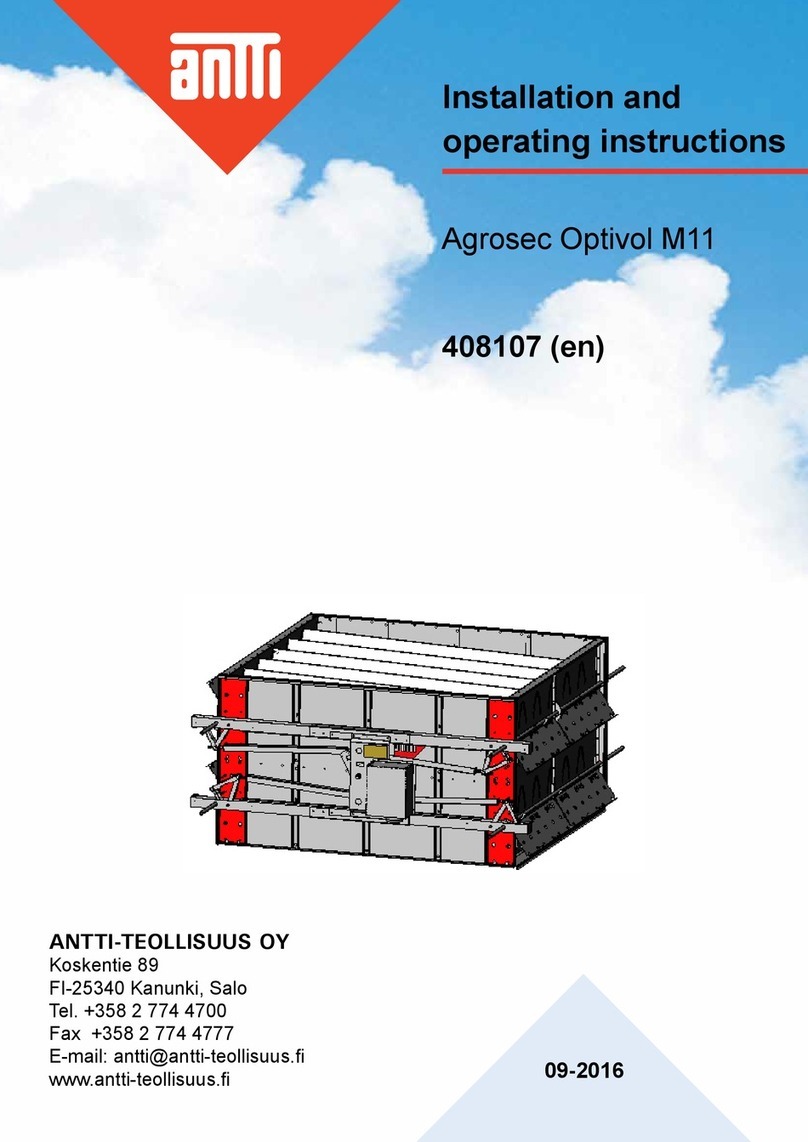
ANTTI
ANTTI Agrosec Optivol M11 Installation and operating instructions
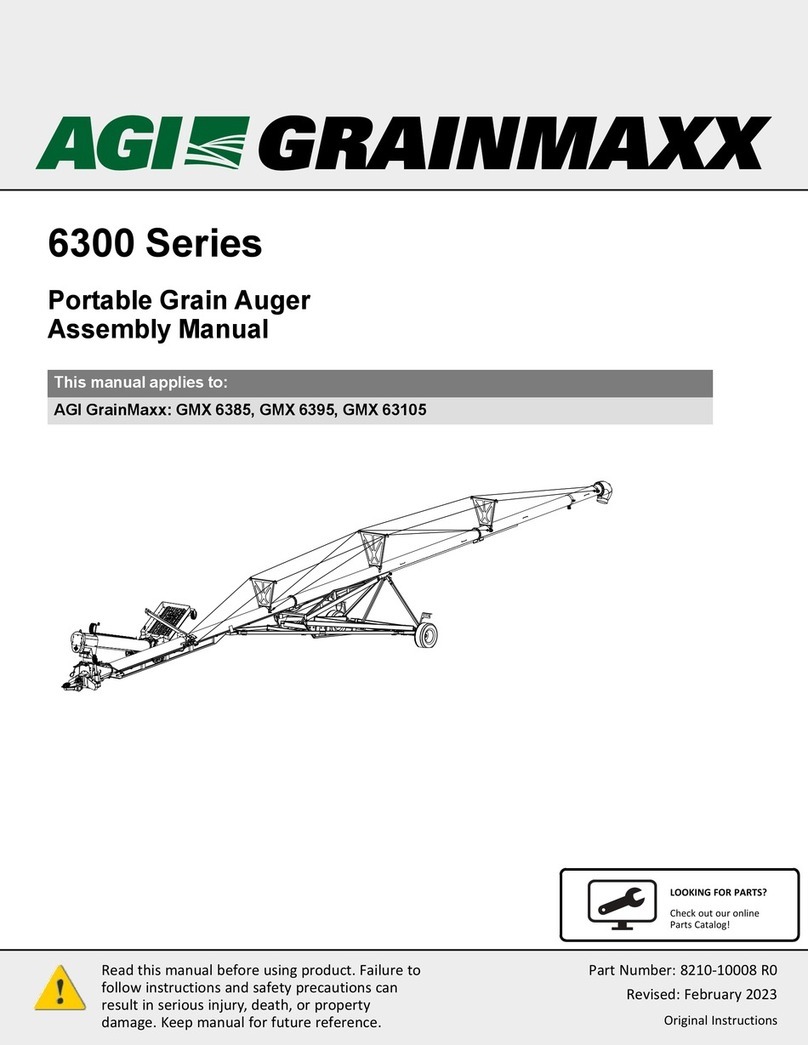
AGI
AGI GRAINMAXX 6300 Series Assembly manual
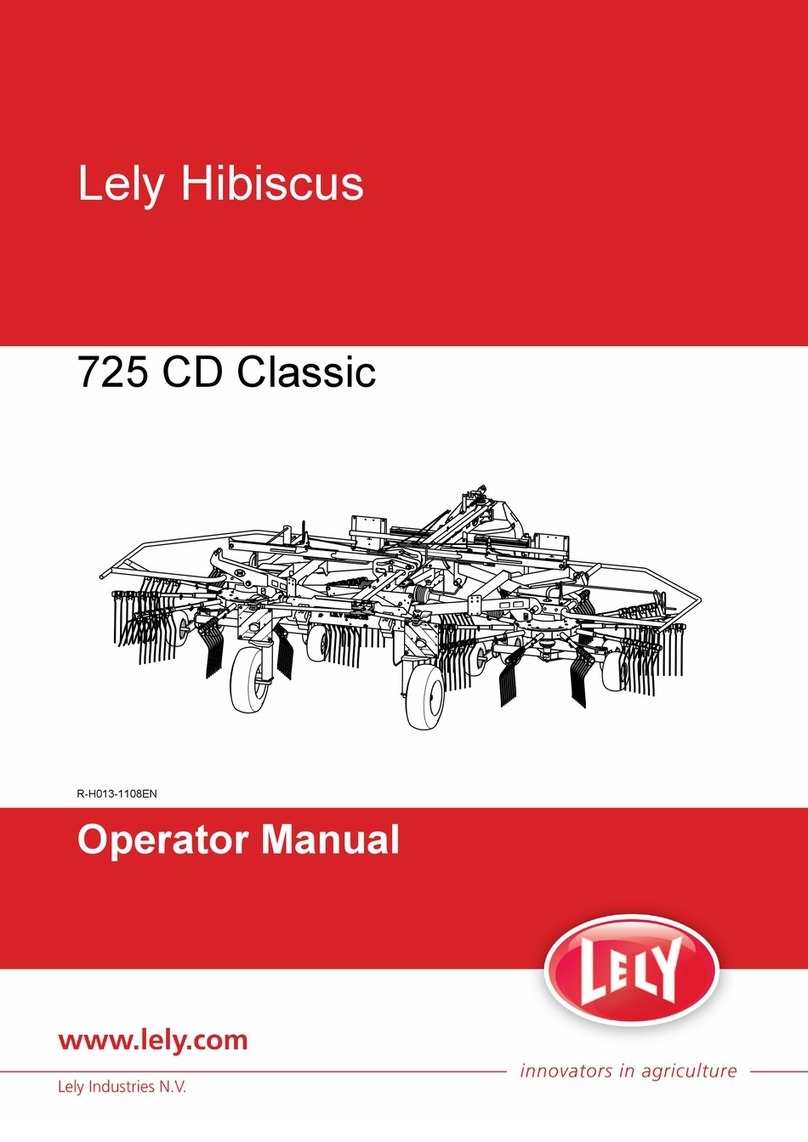
LELY
LELY Hibiscus 725 CD Classic Operator's manual
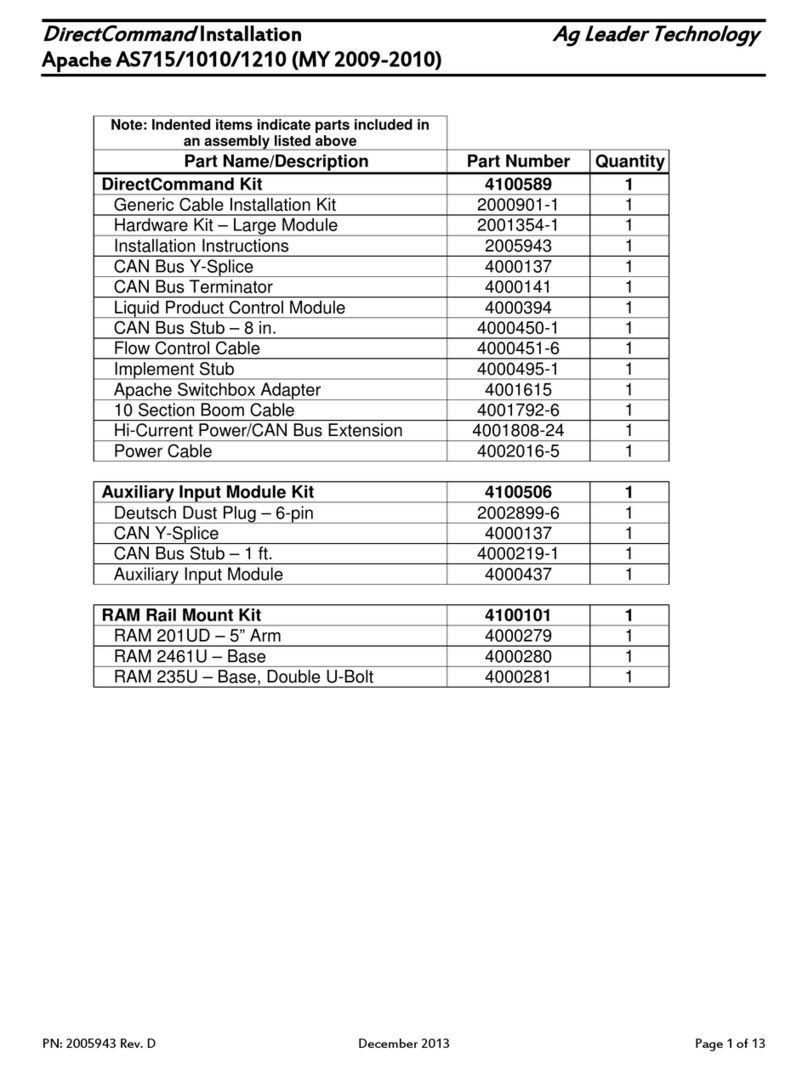
Ag Leader Technology
Ag Leader Technology DirectCommand installation instructions
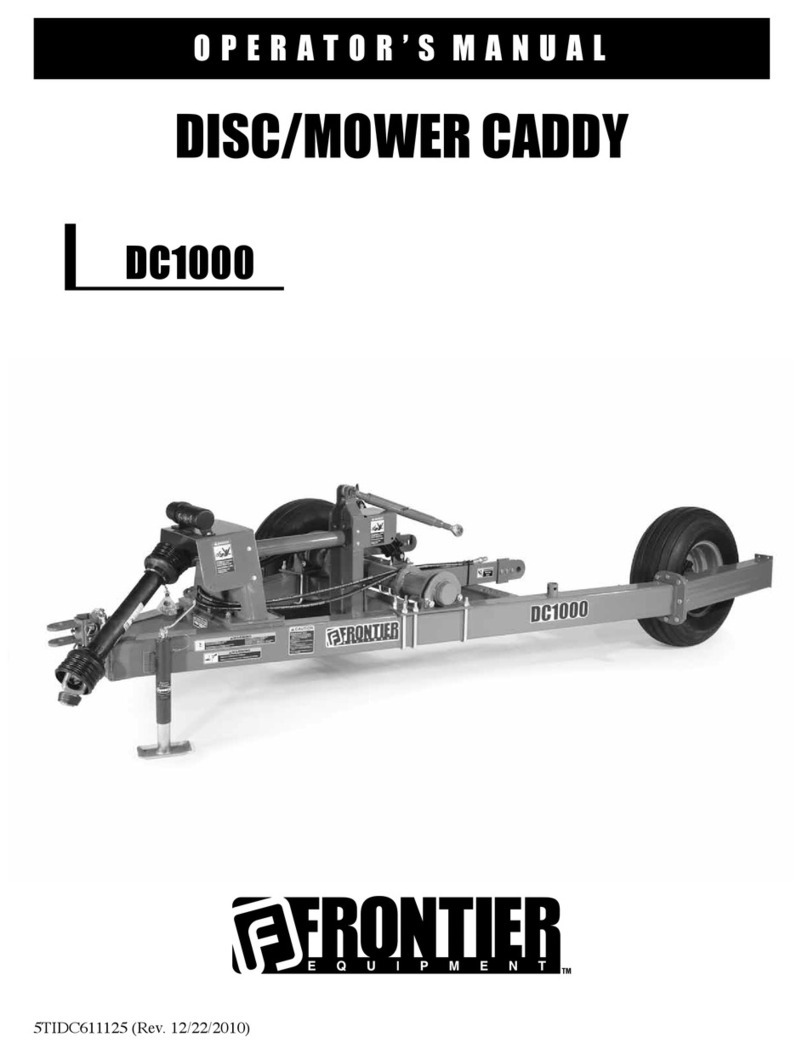
Frontier
Frontier DC1000 Operator's manual
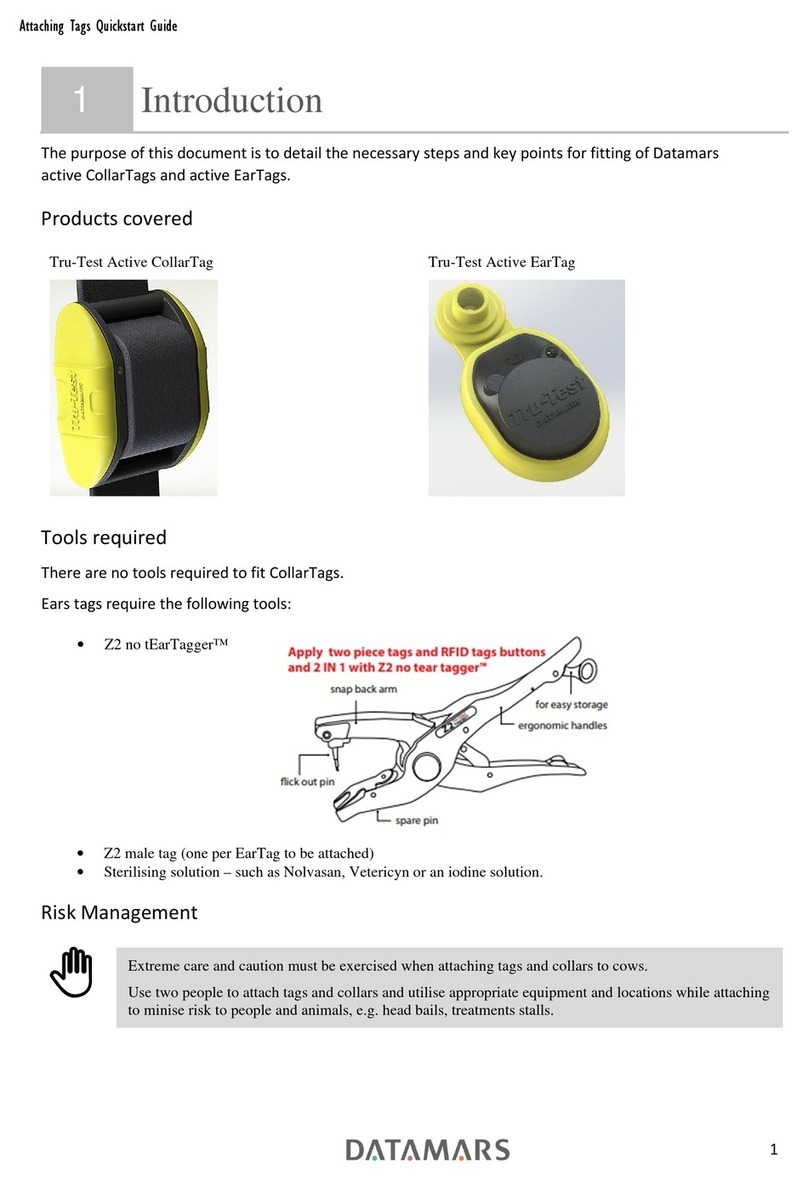
Datamars
Datamars Active CollarTag quick start guide
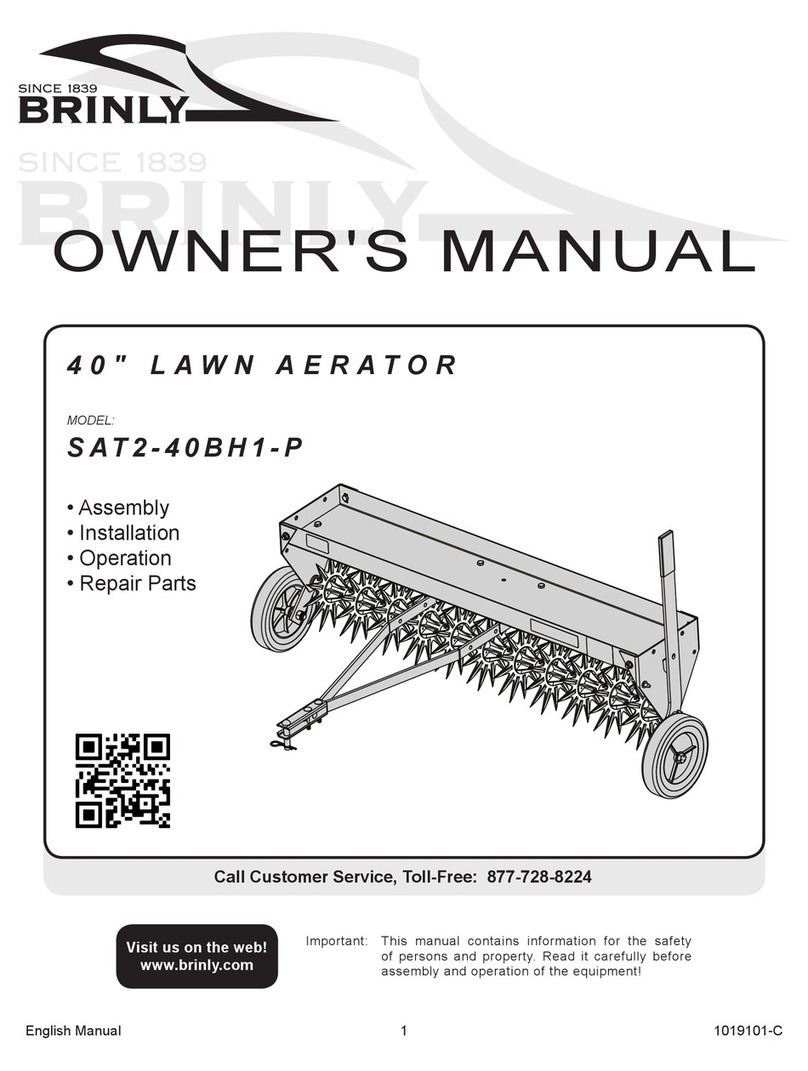
Brinly
Brinly SAT2-40BH1-P owner's manual

